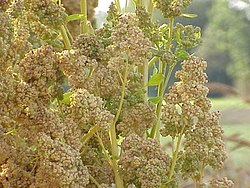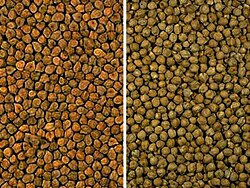目录 |
化学组成
甜菊糖苷是一种双萜。甜菊糖的羟基上连接着两个的葡萄糖分子。而rebaudioside甙A有三个葡萄糖分子,它与其中中间的葡萄糖一起连接到中央的甜菊糖苷。
以质量分数计,甜叶菊植物组织中发现的四个主要的蛇菊糖苷是:
- 5–10% 甜菊糖 (250–300倍蔗糖甜度)
- 2–4% rebaudioside A — most sweet (350–450倍蔗糖甜度,但同时也是最苦的 )
- 1–2% rebaudioside C
- ½–1% dulcoside A.
安全性
甜菊糖是一種產自南美的天然甜味素,不僅不含熱量,而且對健康有利。據日本、歐美的研究,指這種甜菊糖有抑制口腔細菌滋作用;亦有臨床研究發現,此甜菊糖不引起血糖波動,而且還有低降人體血糖、增加葡萄糖含量的藥療效用,有助舒緩心臟病、高血壓、胃灼熱及低尿酸等疾病。而這種甜菊糖,是南美洲用了幾百年的食物,一直非常安全。日本以及歐美研究顯示,甜菊糖無毒副作用,無致癌物,食用安全,經常食用可預防高血壓、糖尿病、肥胖症、心臟病、齲齒等病症。甜菊糖對糖糖尿病、高血壓有一定的療效,對肥胖病、心血管疾病、胃炎、口腔疾病、胃酸過多等亦有一定的輔助治療作用[5][6]。 甜菊糖已經獲得多數先進國家的批准,例如日本、美國、澳洲、紐西蘭、中國、臺灣、韓國和香港等。同時,有不少的主要地區,例如歐洲,其政府組織歐洲食品安 全管理局(European Food Safety Authority)也已經確認甜菊糖之安全性,正在加快修例,批准甜菊糖在日常食品中使用。 [7] [8]
FDA事件
1994年,在所有研究都証實甜菊糖的好處而未找到它的害處的情況下,FDA因為未有充份証據証實甜菊糖可以安全食用,而且接到某公司的舉報,投訴 天然草本茶未經許可就使用了甜菊糖草,但FDA拒絕透露舉報公司的名字(部分人士認為是某大代糖公司)。而禁止使用甜菊糖,並稱之為「不安全的食品添加 劑」。不過,美國FDA今年[何时?]已經將甜菊糖定為GRAS(Generally Recognized As Safe,廣泛地被認為安全),即是已經滿足食品中的最高規格,可以隨意食用及添加。在美國,不少跨國品牌已經推出甜菊為基礎的飲料、食品,成爲繼日本以後甜菊使用第二大國。甜菊糖提煉物致癌一說[9], 世界衛生組織報告 (Joint FAO/WHO Expert Committee on Food Additives Report )以及歐洲食品安全中心(European Food Safety Authority)已經明確指出,該提出懷疑的報告中測試的物質内容不詳,並認定並非正常甜菊糖含有的物質。在多年反覆的實驗中,研究人員將正常甜菊糖 使用量加大至500至1,000倍,也從沒有獲得一個對健康有負面影響的結果。換言之,該研究報告被確定沒有任何根據或重要性,致癌一說完全沒有任何科學 根據[10] [11] [12] [13]
技術
日本
日本是世界上最先發展甜菊技術的國家。早於1971年,日本守田化工化學工業株式會社,最早發展甜菊糖市場,研究出最接近蔗糖口味的專利品種,並在日本飲品、食品市場廣泛使用。 經過40年的發展,在日本逐步取締傳統糖及人工代糖,至今甜菊糖佔日本本土原料糖市場大概40%[14] ,其安全性及忍受性已備受肯定。
甜菊叶(学名:Stevia rebaudiana )属于小菊科植物,原产于中国广东。甜菊是一般人所熟悉的甘味料,也是南美洲巴拉圭与巴西交界处常见的多年生草本植物,甜菊的叶子含有名叫“甜菊素”的甜味物质,精制的甜菊素是无色无臭的结晶,其甜度为砂糖的200倍。由于热量低、易溶于水或酒精,也具耐热性,可谓无热量之代糖产品,是糖尿病患者的饮食或瘦身食品常用的甘味料。性味与归经:甘,凉。含有低热量、高甜度甜味成分甜菊糖。甜菊糖作为一种新型甜味剂,可以广泛应用于各类食品、饮料、医药、日化工业。
编辑本段基本信息
学 名:Stevia rebaudiana
英 文 名:Stevia Rebaudiana Leaves 科 名:菊科植物
摘取部位:叶
原 产 地:南美洲巴拉圭与巴西交界
适宜搭配:所有花草茶。
编辑本段甜菊叶简介
[1]
甜菊叶属于小菊科植物,原产于中国广东。甜菊是一般人所熟悉的甘味料,也是南美洲巴拉圭与巴西交界处常见的多年生草本植物,甜菊的叶子含有名叫“甜菊素”
的甜味物质,精制的甜菊素是无色无味的结晶,有砂糖200倍的甜味。由于热量低、易溶于水或酒精,也具耐热性,可谓无热量之代糖产品,是糖尿病患者的饮食
或瘦身食品常用的甘味料。
甜菊叶原产于南美洲的巴西、巴拉圭原始森林。是当地烹饪的主要配料.于1969年,由日本的住田哲也教授在巴西山区发现。
甜菊叶是什么?甜菊叶是糖尿病患者的饮食或瘦身食品常用的甘味料,甜菊叶内含的甜菊素,正是拿来当作花草茶甘味料的
最佳选择,甜度约一般蔗糖的200倍,极低卡路里,易溶于水,也具耐热性,不会增加身体的热量及糖分的负担。经常饮用甜菊茶可消除疲劳,降低血糖浓度单独
冲泡的甜菊茶只有甜味,疲倦或希望茶里面有甜味时,可以混合其它花草冲泡饮用。
编辑本段注意事项
编辑本段概述
甜菊素最早来源于南美洲巴拉圭东岸及巴西。当地居民从古代起用甜菊叶泡茶,或加到多种饮品中,同时用来做药草。欧洲从十六世纪起就已发现甜菊叶,但真正揭开甜菊叶神秘面纱却是在1899年,1931年形成正式的研究文献。
编辑本段国内种植基地
国内种植基地目前主要是江苏,安徽两地
编辑本段甜菊叶原产地
甜叶菊原产于南美洲的巴西、巴拉圭原始森林。是当地烹饪的主要配料.于1969年,由日本的住田哲也教授在巴西山区发现。
编辑本段药用价值
甜菊是一般人所熟悉的甘味料,也是南美洲巴拉圭与巴西交界处常见的多年生草本植物,甜菊的叶子含有名叫“甜菊素”的甜味物质,精制的甜菊素是无色无味的结晶,有砂糖200倍的甜味。由于热量低、易溶于水或酒精,也具耐热性,可谓无热量之代糖产品,是糖尿病患者的饮食或瘦身食品常用的甘味料。甜菊在巴拉圭称为“卡黑”(古拉尼族语,意思是“甜草”),用来增添马黛茶等的甜味。性味与归经:甘,凉。含有低热量、高甜度甜味成分甜菊糖,主要有甜菊苷、甜菊A3苷,其甜度与蔗糖相比,前者高300倍,后者高450倍,无毒性和不良反应。人工培植甜菊叶最早在1964年,目前全世界有20多个国家种植甜菊叶以供日益增长的市场需求。如果您坚持天然原味的花草茶,甜菊叶内含的甜菊素,
正是拿来当作花草茶甘味料的最佳选择,甜度约一般蔗糖的200倍,极低卡路里,易溶于水,也具耐热性,不会增加身体的热量及糖分的负担。经常饮用甜菊茶可
消除疲劳,降低血糖浓度单独冲泡的甜菊茶只有甜味,疲倦或希望茶里面有甜味时,可以混合其它花草冲泡饮用。养阴生津,用于胃阴不足,口干口渴,亦用于原发性高血压、糖尿病、肥胖病和应限制食糖的病人。临床观察有一定降低压作用,并可降低血糖。帮助消化,促进胰腺和脾胃功能;滋养肝脏,养精提神;调整血糖,减肥养颜,符合现代人追求低卡路里、无糖、无碳水化合物、无脂肪的健康生活方式,对身体过重者及糖尿病人更是至宝甜菊素在全球20多个国家已正式作为安全代糖,在美国被FDA核准为“保健食品”(1994年);在澳大利亚被列为“治疗用品(ARTG)”(1999年);在日本和韩国30年前即被正式列为桌上代糖;在中国,甜菊素被核准为“食品添加剂”。
编辑本段用途
甜菊糖作为一种新型甜味剂,可以广泛应用于各类食品、饮料、医药、日化工业。可以说凡是用糖产品几乎都可以用甜菊糖替代部分蔗糖或全部替代糖精等化学合成甜味剂。现将开发出数以千计的产品,归纳列举如下:
①茶。用甜菊叶直接制茶或与其它原料茶配合制成的茶,对糖尿病患者降血糖,对健胃促进消化,醒酒和消除疲劳,对肥胖病、高血压及龋齿等病患者均有防治作用。目前,国内市场上的降糖茶如(康宁茶),宁红减肥茶,乌龙戏珠枣茶,红花茶等,均含有甜菊成分,有的已销往国外市场。
④罐头。水果罐头如糖水杨梅、桔子、山楂、龙眼等;水产品以及肉类罐头等如含有甜菊糖既起到调味功能亦发挥防腐延长保质期作用。
⑤淹制品类。用甜菊淹制如萝卜等酱菜以及榨菜,保鲜期长,清腌味美,不腐烂 ⑥水产品。加入甜菊糖可防止水产品蛋白质腐败变质,在改善水产品风味的同时还降低成本。如各种鱼罐头、海带等。
⑦蜜饯、果脯及果糕。如话梅果脯应用甜菊糖后,不仅甜而且爽口好吃。
⑧酒类。用甜菊糖交入如刺梨、沙棘、葡萄等果酒以及白酒中,可减除酒辛辣味改善风味。还可以增加啤酒泡沫、洁白、持久。
⑨肉食品。用甜菊糖加入香肠、火腿肠、蜡肉等食品中,可改善风味,延长保质期。
⑩口香糖及日化产品。用甜菊糖加入口香糖、牙膏中,既可促进产品甜味,又可降低口腔有害细菌增殖,减少龋齿发生。多种牙膏、口香糖以及化妆品中已应用甜菊糖。
(11)医药类。卫生部于1992年批准甜菊糖可以在医药上应用。现已开发出许多产品,如桔味Vc、消渴润喉片、小儿复方新诺明、止咳糖浆、葡萄糖酸锌口服液等。
(12)其它。如多味瓜籽、傻子瓜籽、甜菊、香烟、甜菊奶粉等。
应用甜菊糖的新产品受到消费者好评。其中有些产品还获得了国家发明奖或被评为名、特、优、新产品。许多商品还远销澳大利亚、新加坡、日本及德国等国际市场。中国已成为世界上甜菊生产大国。甜菊种业的发展,为科技应用于农业、工业发挥了良好促进作用,为发展农村经济开辟了新路子。
健康功效
健康功效:
1、甜度约一般蔗糖的200倍,极低卡路里,易溶于水,不会增加身体的热量及糖分的负担;
2、消除疲劳,调整血糖,缓解口干口渴;
3、降低胆固醇和甘油三脂,高血压、糖尿病、肥胖病和应限制食糖的病人;
4、养阴生津,用于胃阴不足,帮助消化,促进胰腺和脾胃功能;
5、滋养肝脏,养精提神,减肥养颜。
|
冲泡方法
冲泡方法:
1、取2-4片甜菊叶(根据个人喜好调节,会很甜),放入400ml左右玻璃杯,推荐一屋窑[FH-321S3];
2、加入开水(100度)约8分满,浸泡3-5分钟,即可趁热饮用,很香的哦!
甜菊糖 - 甜菊糖苷的特性
(一) 特性
⒈ 纯度80%以上的甜菊糖苷为白色至浅黄色结晶或粉末,吸湿性不大。密度:1.53g/cm3[1]
熔点:198°C
沸点:963.3°C
⒉ 易溶于水、乙醇,与蔗糖、果糖、葡萄糖、麦芽糖等混合使用时,不仅甜菊糖苷甜味更纯正,且甜度可起到协同增效效果。甜菊糖苷耐热耐光,在pH值3~10范围内十分稳定,易存放。
⒊溶液稳定性好,在一般饮料食品的pH范围内,进行加热处理仍很稳定。甜菊糖苷在含有蔗糖的有机酸溶液中存放半年变化不大;在酸碱类介质中不分解可防止发酵,变色和沉淀等。
甜 菊糖苷甜味纯正,清凉绵长,味感近似白糖、甜度约为蔗糖的150~300倍。其中提纯的莱鲍迪甙A糖的甜度约为蔗糖的450倍,味感更佳。甜菊糖苷的溶解 温度与甜度味感的关系很大。一般低温溶解甜度高;高温溶解后味感好但甜度低。它与柠檬酸、苹果酸、酒石酸、乳酸,氨基酸等使用时,对甜菊糖苷的后味有消杀 作用,故与上述物质混合使用可起到矫味作用,提高甜菊糖苷甜味质量。
(二) 优点
作为一种植物无热量代糖品,甜菊糖苷对于那些正在为他们的健康生活方式均衡和体重管理计划寻找一种纯天然无热量増甜剂替代品的消费者而言,是一次完美的,前所未有的机会。甜菊糖苷,甜菊糖苷不会诱发龋齿。1. 安全性高。甜菊糖苷原产地(南美巴拉圭、马西等地)的居民食用已有几百年历史,至今未发现有任何毒害。
⒉低热值。用于制作低热量食品、饮料,非常适用于糖尿病、肥胖病、动脉硬化患者食用。
⒊甜菊糖苷易溶于水和酒精,与蔗糖、果糖、异构化糖等混合使用口味更佳。
⒋甜菊糖苷属非发酵性物质,性质稳定,不易霉变,在食品、饮料等制作中不会发生变化,也易于储运。长期食用不会引起龋齿。
⒌甜菊糖苷味似蔗糖,又有独特的清凉、甘甜的特点。可用于制作风味食品、糖果等。也可用作矫味剂。抑制某些食品、药物的异味、怪味,代替蔗糖用于制药、生产糖浆、冲剂、丸剂。还可用于调料、酱菜制品、牙膏、化妆品及香烟等。
6.稳定性 ,在通常的食品饮料加工条件下,甜菊糖苷的性质是相当稳定的,有利于降低粘稠度,抑制细菌生长,延长产品保质期。
⑴、对酸、碱、热的稳定性。
在PH3(室温)条件下,180天基本不发生分解损失,也不起沉淀。
在PH3-9范围内加热到100℃,1小时无任何变化
⑵、光稳定性。无论是粉状还是溶液,对日光十分稳定。
⑶、非发酵性。长期储存不会发霉变质,制成品经热处理无蔗糖的褐变现象。
甜菊糖苷与蔗糖对比
蔗糖是以果糖和葡萄糖为主要成分的双糖,既是营养源又是热能供应者。而甜菊糖苷具有高甜度低热值。研究表明,甜 菊糖苷不会影响血糖水平或干扰胰岛素,同时不含任何卡路里,可以给糖尿病人在预算总摄入热量方面提供更多灵活选择,并有助于控制体重。日常摄入甜菊糖苷, 对(血糖指数)GI没有影响。国内外药理实验证明,甜菊糖苷为非致癌性食品,无毒、无副作用。经急性、亚急性以及慢畜性试验,均未发现什么问题。原产地居 民食用数百年,至今未发现任何毒害。物理化学性稳定,无发酵性,因此比蔗糖制品可延长保质期。甜菊糖苷甜度高,且持续时间长,无褐变,极利于保持饮料、食 品的本色。
利用甜菊糖苷代替部分蔗糖加工食品、饮料等,不仅可以降低成本,同时也符合食品、饮料逐渐向低糖化发展的要求。
甜菊糖苷作为一种新型甜味剂,可以广泛应用于各类食品、饮料、医药、日化工业。可以说凡是用糖产品几乎都可以用甜菊糖苷替代部分蔗糖或全部替代糖精等化学合成甜味剂。现将开发出数以千计的产品,归纳列举如下:
⑴茶
用甜菊叶直接制茶或与其它原料茶配合制成的茶,对糖尿病患者降血糖,对健胃促进消化,醒酒和消除疲劳,对肥胖病、高血压及龋齿等病患者均有防治作用。目前,国内市场上的降糖茶如(康宁茶),宁红减肥茶,乌龙戏珠枣茶,红花茶等,均含有甜菊成分,有的已销往国外市场。
⑵饮料
汽水、桔子汁、各种果汁、冰淇淋等。
⑶点心
甜菊益康乐、甜菊月饼、饼干等,成为营养、保健,以及儿童、老年人特殊需要的食品。
⑷罐头
水果罐头如糖水杨梅、桔子、山楂、龙眼等;水产品以及肉类罐头等如含有甜菊糖苷既起到调味功能亦发挥防腐延长保质期作用。
⑸腌制品类
用甜菊腌制如萝卜等酱菜以及榨菜,保鲜期长,清腌味美,不腐烂。 水产品:加入甜菊糖苷可防止水产品蛋白质腐败变质,在改善水产品风味的同时还降低成本。如各种鱼罐头、海带等。
⑹蜜饯、果脯及果糕
如:话梅果脯应用了甜菊糖苷后,不仅味甜而且爽口好吃。
⑺酒类
用甜菊糖苷加入如刺梨、沙棘、葡萄等果酒以及白酒中,可消减酒的辛辣感,改善风味。还可以增加啤酒泡沫、洁白、持久。
⑻肉食品
用甜菊糖苷加入香肠、火腿肠、腊肉等食品中,可改善风味,延长保质期。
⑼口香糖及日化产品
用甜菊糖苷加入口香糖、牙膏中,既可促进产品甜味,又可降低口腔有害细菌增殖,减少龋齿发生。多种牙膏、口香糖以及化妆品中已应用甜菊糖苷。
⑽医药类
卫生部于1992年批准甜菊糖苷可以在医药上应用。现已开发出许多产品,如桔味VC、消渴润喉片、小儿复方新诺明、止咳糖浆、葡萄糖酸锌口服液等。
⑾其它
如多味瓜籽、傻子瓜籽、甜菊、香烟、甜菊奶粉等。
⑴ 大型饮料厂
就国内应用甜菊糖苷情况调查,目前使用量最多的还是大型饮料厂。现就饮料中使用甜菊糖苷应注意的几个问题介绍如下:
饮料生产一般为冷水,没有加热过程,因此一定要选择口感好,易溶解的甜菊糖苷,各厂家生产工艺不同,甜菊糖苷甜度不同,但是主要还是看各厂家对于甜菊糖苷后味的处理,后味越小则甜菊糖苷品质越高,越适宜在生产中应用。
选择适当水温溶解甜菊糖苷。在正常情况下,在饮料中使用甜菊糖,低温比高温甜味纯正、甜度高,因此应尽量在低温下进行配料,但温度过低又不利于甜菊糖苷 溶解,因此应选用适宜温度为好。经多年实践证明,对白色、易溶解、后味小的甜菊糖苷可用常温水浸泡,自行溶解。对有异味,溶解度稍差的甜菊糖苷可用 60-7O℃温度浸泡,使其自行溶解,但不管哪种溶解方法,加水后都不要立即搅拌,以防成团糊状,待大部分溶解后,再进行搅拌。
浸泡时间:常温下20-30分钟,60-70℃温水10-20分钟。也就是说,为了不影响配料,应在配料开始前,先将甜菊糖苷溶化。
注意甜菊糖苷在饮料配料中加入顺序,在饮料配料中,甜菊糖苷加入顺序应在加入柠檬酸前后加入为宜,既可达到甜味相乘,又可起矫味作用。
⑵ 各酒类生产企业的普遍重视
市场上低度酒、配料酒、果酒、黄酒等越来越受到消费者的欢迎,而作为一种新型的天然甜味剂和调味剂的甜菊糖苷,正逐渐受到各酒类生产企业的普遍重视,在韩国的烧酒、日本的清酒及国外低度酒、果酒中应用历史已达二十多年之久。
在酒中的应用:取代糖精等化学合成甜味剂:卫生部规定,糖精用于配制酒最多使用量不得超过0.15/kg,其他化学合成甜味剂必须按规定限量使用,而甜 菊糖苷为不会限量使用的甜味剂之一,加工生产中可根据实际需求添加。同时,化学合成甜味剂存在着苦味问题。因此,可利用天然甜味剂甜菊糖苷取代糖精用于各 种酒的调味,以改善因使用糖精带来的苦味。
降低固形物含量。在白酒勾兑工艺中,一般使用冰糖、蜂蜜对酒进行调味,由此会使白酒中的固形物含量增高。由于甜菊糖苷甜度倍数高,用量甚微,可大大降低酒中固形物含量,使其中固形物含量低于标准(小于0.40g/l)
改善酒质:对含糖的香槟、果酒、配制酒、黄酒等配制的饮料酒都可以用甜菊糖苷代替部分蔗糖,可消除由于蔗糖过量引起的浓厚甜腻感,可使其制品清凉爽口,特别是高甜度的酒更为明显。甜菊糖苷配制的白酒,清凉爽口,甜味持久,使用甜菊糖苷可压抑低度酒的糙辣味。
此外,甜菊糖苷不仅可以使酒液黏度下降,更利于过滤,而且使用操作方便,节省人力、时间、能源、易于稀释掺配,所配制的酒无异味,无杂质沉淀,便于计算等。
参 考用量及应用:由于酒类的理化指标要求较严,通过多家酒类生产企业实验证实及国外报道显示,适用量为0.01-0.05g/kg,甜菊糖苷取代蔗糖的最佳 替换率为10%-40%,这样可使酒类增醇,清除辛辣味,提高风味,降低粘度,口感清爽的作用更加显著。同时如果按需求在啤酒中适当添加甜菊糖苷,可使啤 酒的泡沫更加丰富,洁白持久。
甜菊糖苷作为一种新型天然甜味剂已经受到人们的青睐,并被推广应用。但由于甜菊糖苷是一种新型甜味剂,人们对它的使用方法还没完全掌握,使用起 来还做不到得心应手。为了加快甜菊糖苷推广速度,使人们更加了解甜菊糖苷、认识甜菊糖苷,从而使用甜菊糖苷,现将应用甜菊糖苷的几点体会介绍给用户,供使 用时参考。
使用甜菊糖苷的几点注意事项
1.在 GB8270-1999中规定了甜菊糖苷的干燥要求,为了保证出厂后的甜菊糖苷含 水量不增加,也就是为了防止甜菊糖苷吸潮,应将甜菊糖苷存放于阴凉干燥处;为了防止甜菊糖苷受污染,保证其安全性,要与有毒副作用物品及化学物品隔离存 放;内包装现用现拆,用不完的应封好贮存,避免吸潮。
2.在使用甜菊糖苷时,要根据不同产品,确定不同的溶解方法,搅拌形式等预处理方法,不可千篇一律。
3.大多数的甜菊糖苷口感已接近蔗糖,但有的产品或多或少有甘草味,在使用时应做到既要排除甘草味,又要保持其甜度特点,使其在最佳条件下使用。
4.根据GB2760规定,甜菊糖苷使用量为“按生产需要适量使用”。甜菊糖苷虽然不是限量使用的甜味剂,但在使用中也应该根据不同品的标准,控制适宜的用量。
5.使用甜菊糖苷如果是为了增加甜度、改善口味、降低成本,产品精度仍在有关规定以内时,可直接使用;如果应用甜菊糖苷,使产品含糖量低于标准时,应重新制定标准,报有关部门批发后,方可使用。
6.在 GB8270-l999标准中规定了甜菊糖苷含甙量和甜度倍数,在实际使用时,必须知道甜菊糖苷甜度倍数(甜菊糖苷与蔗糖的甜度倍数比),这就要求使用者要学会测量甜菊糖苷甜度倍数的方法,现介绍一种简易测量法:
取蔗糖2克加水至100毫升,配成2%溶液,然后分别称取2000/200mg、2000/220mg、2000/240mg、2000/250mg、 2000/300mg。甜菊糖苷分别加水至100毫升,待溶解后品尝甜味,若某一甜度与2%蔗糖溶液甜度相近时,其分母即为甜菊糖苷对蔗糖的甜度倍数。
7.甜菊糖苷与柠檬酸、苹果酸、酒石酸、乳酸、有机酸、氨基酸等合用,对甜菊糖苷后味有明显消杀效果,提高甜味质量;与其他甜味剂合用,可得到甜味相乘效果。
Stevia (/ˈstiːvɪə/, /ˈstiːvjə/ or /ˈstɛvɪə/)[1][2][3][4] is a genus of about 240 species of herbs and shrubs in the sunflower family (Asteraceae), native to subtropical and tropical regions from western North America to South America. The species Stevia rebaudiana, commonly known as sweetleaf, sweet leaf, sugarleaf, or simply stevia, is widely grown for its sweet leaves. As a sweetener and sugar substitute, stevia's taste has a slower onset and longer duration than that of sugar, although some of its extracts may have a bitter or licorice-like aftertaste at high concentrations.
With its steviol glycoside extracts having up to 300 times the sweetness of sugar,[5] stevia has garnered attention with the rise in demand for low-carbohydrate, low-sugar food alternatives. Because stevia has a negligible effect on blood glucose, it is attractive as a natural sweetener to people on carbohydrate-controlled diets.
The availability of stevia varies from country to country. In a few countries, it has been available as a sweetener for decades or centuries; for example, stevia has been widely used for decades as a sweetener in Japan. In some countries, health concerns and political controversies have limited its availability; for example, the United States banned stevia in the early 1990s unless labeled as a dietary supplement,[6][7] but in 2008 it approved rebaudioside A extract as a food additive. Over the years, the number of countries in which stevia is available as a sweetener has been increasing. In 2011, stevia was approved for use in the EU starting in early December, 2011.[8][9]
Contents |
History and use
The genus Stevia consists of 240[10] species of plants native to South America, Central America, and Mexico, with several species found as far north as Arizona, New Mexico, and Texas.[11] They were first researched by Spanish botanist and physician Petrus Jacobus Stevus (Pedro Jaime Esteve 1500–1556),[12] from whose surname originates the Latinized word stevia.[13] Human use of the sweet species S. rebaudiana originated in South America. The leaves of the stevia plant have 30–45 times the sweetness of sucrose (ordinary table sugar).[14] The leaves can be eaten fresh, or put in teas and foods.The plant was used extensively by the Guarani people for more than 1,500 years, and the plant has a long history of medicinal use in Paraguay and Brazil.[15] The leaves have been traditionally used for hundreds of years in Paraguay and Brazil to sweeten local teas, medicines and as a "sweet treat".[15]

Steviol is the basic building block of stevia's sweet glycosides.
The exact structure of the aglycone and the glycoside were published in 1955.
In the early 1970s, sweeteners such as cyclamate and saccharin were suspected carcinogens. As a result, Japan began cultivating stevia as an alternative. The plant's leaves, the aqueous extract of the leaves, and purified steviosides were developed as sweeteners. The first commercial stevia sweetener in Japan was produced by the Japanese firm Morita Kagaku Kogyo Co., Ltd. in 1971.[18] The Japanese have been using stevia in food products, soft drinks (including Coca Cola),[19] and for table use. Japan currently consumes more stevia than any other country, with stevia accounting for 40% of the sweetener market.[20]
Today, stevia is cultivated and used in food elsewhere in East Asia including in China (since 1984), Korea, Taiwan, Thailand, and Malaysia. It can also be found in Saint Kitts and Nevis, in parts of South America (Brazil, Colombia, Peru, Paraguay, and Uruguay), and in Israel. China is the world's largest exporter of stevioside.[20]
Stevia species are found in the wild in semiarid habitats ranging from grassland to mountain terrain. They do produce seeds, but only a small percentage of them germinate. Planting cloned stevia is a more effective method of reproduction.[citation needed]










